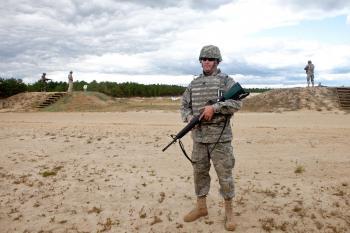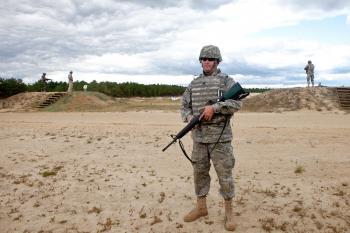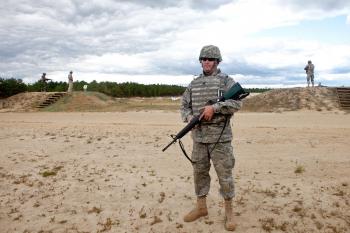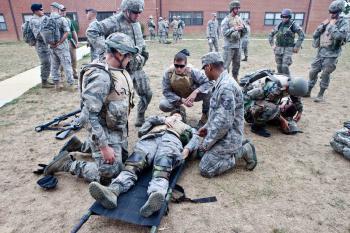JOINT BASE MCGUIRE-DIX-LAKEHURST, New Jersey—A flight a couple weeks away will mark the 15th time Capt. Jeremy Morrill has deployed overseas. As an officer assigned to finding and overseeing contractors for the U.S. Air Force, Morrill has seen a different side of the war, but one that is playing a larger and larger role in U.S. operations.
Gunfire erupted from the live firing range behind him, a voice came over a megaphone, speaking orders to the trainees. After nearly 20 years on the job, for Morrill, on Sept. 10, the pre-deployment training at the United States Air Force Expeditionary Center at Joint Base McGuire-Dix-Lakehurst was almost second nature.
On some days the trainees do live fire training, while during other times, they learn to drive in a convoy, train on how to find an improvised explosive device (IED), or learn to provide first aid while under fire. “You hope you never have to use it, but it’s good to have a general understanding of it in case you do,” Morrill said, referring to first aid.
The U.S. Air Force adopted a more fluid system of pre-deployment training last year, which is used for all airmen. Much of the training that is given was developed from recommendations by troops on the ground in Iraq and Afghanistan.
Being responsible for finding local suppliers, builders, and other professionals, doesn’t sound like the most exciting job the armed forces have to offer, but Morrill and others in his profession put their lives on the line every day.
“You have people who don’t like you, and you still have got to go out and find things and get things done; so it’s very tough,” he said.
With the end of Operation Iraqi Freedom, and the beginning of Operation New Dawn, local contractors will begin playing a larger role in rebuilding Iraq, and airmen like Morrill are the ones who need to go out and find them.
“There’s no power grid, there’s no water treatment plants, there’s no sewage systems—there’s none of this stuff,” Morrill said. “So, somebody has got to go in there. … They may use an Army Corps of Engineers to train for a lot of that stuff, but somebody has got to go out and buy it, and sustain it, and build.”
“We can do those things, but we can’t keep doing it forever,” he added. “So we have to teach them to do it.”
Great Opportunities and Deadly Risks
In 2009, NATO and the United States spent nearly $14 billion on contracting services, according to the International Security Assistance Force (ISAF).
Hiring contractors has proven to be useful from many angles. The practice provides local jobs, creates infrastructure, and saves the United States much-needed funds. According to Morrill, if the United States shipped materials from outside the country, overall cost would greatly rise because of fuel and distribution expenses.
Gunfire erupted from the live firing range behind him, a voice came over a megaphone, speaking orders to the trainees. After nearly 20 years on the job, for Morrill, on Sept. 10, the pre-deployment training at the United States Air Force Expeditionary Center at Joint Base McGuire-Dix-Lakehurst was almost second nature.
On some days the trainees do live fire training, while during other times, they learn to drive in a convoy, train on how to find an improvised explosive device (IED), or learn to provide first aid while under fire. “You hope you never have to use it, but it’s good to have a general understanding of it in case you do,” Morrill said, referring to first aid.
The U.S. Air Force adopted a more fluid system of pre-deployment training last year, which is used for all airmen. Much of the training that is given was developed from recommendations by troops on the ground in Iraq and Afghanistan.
Being responsible for finding local suppliers, builders, and other professionals, doesn’t sound like the most exciting job the armed forces have to offer, but Morrill and others in his profession put their lives on the line every day.
“You have people who don’t like you, and you still have got to go out and find things and get things done; so it’s very tough,” he said.
With the end of Operation Iraqi Freedom, and the beginning of Operation New Dawn, local contractors will begin playing a larger role in rebuilding Iraq, and airmen like Morrill are the ones who need to go out and find them.
“There’s no power grid, there’s no water treatment plants, there’s no sewage systems—there’s none of this stuff,” Morrill said. “So, somebody has got to go in there. … They may use an Army Corps of Engineers to train for a lot of that stuff, but somebody has got to go out and buy it, and sustain it, and build.”
“We can do those things, but we can’t keep doing it forever,” he added. “So we have to teach them to do it.”
Great Opportunities and Deadly Risks
In 2009, NATO and the United States spent nearly $14 billion on contracting services, according to the International Security Assistance Force (ISAF).
Hiring contractors has proven to be useful from many angles. The practice provides local jobs, creates infrastructure, and saves the United States much-needed funds. According to Morrill, if the United States shipped materials from outside the country, overall cost would greatly rise because of fuel and distribution expenses.
Continued on the next page...
However, there are inherent risks to hiring local contractors, which were outlined in a Sept. 13 letter written by General David Petraeus, commander of the International Security Assistance Force (ISAF) and U.S. troops in Afghanistan.
According to Petraeus, the scale of U.S. contracting efforts “represents both an opportunity and a danger,” since if there is not proper and thorough oversight, the funds can “unintentionally fuel corruption, finance insurgent organizations, strengthen criminal patronage networks, and undermine our efforts.”
To help resolve some of the risks in Afghanistan, Petraeus set new guidelines on hiring local contractors, to prevent creating monopolies or funding individuals who will use the funds to launch attacks against U.S. forces.
“In view of these points, contracting has to be ‘Commander’s business.’ Indeed, I expect commanders to consider the effects of our contract spending and understand who benefits from it,” Petraeus said. “We must use intelligence to inform our contracting and ensure those with whom we contract work for the best interests of the Afghan people. We must be better buyers and buy from better people.”
From Beans to Bullets
With COMISAF’s Counterinsurgency (COIN) in Afghanistan, and the new mission in Iraq, contractors are playing a larger role in U.S. military operations.
“We buy everything from beans to bullets,” Morrill said. “Usually when you go out there, there’s not an industry that can support, so its up to us to establish that industry, or find a way to get those items that everybody needs in the theater.”
The U.S. Air Force has been doing this since 1991, in areas ranging from Bosnia and Kosovo, to Iraq and Afghanistan.
The work is multifaceted. When deployed, Morrill and other contracting offices need to track down individuals who have the needed skills and then monitor the worksites to make sure that the work is being completed. After, he needs to bring a military staff member with him who is authorized to pay the vendors.
Each time they leave the base and travel to local towns, they are accompanied by armed guards.
Although he hasn’t been in direct combat, enemy fire is a regular part of the job. According to Morrill, “Almost everywhere I’ve been, [I have] received indirect fire, you know rockets, we’ll hear sporadic gunfire.”
He says he tries to avoid traveling in convoys, and when possible, he prefers traveling by helicopter. “Last time we were there in Iraq, I was only there a couple days, and we had one of our contracting guys get hit on a convoy. He had to go to surgery and had some messed up knees and things like that. But it happens. It’s happened a lot,” Morrill said.
According to Petraeus, the scale of U.S. contracting efforts “represents both an opportunity and a danger,” since if there is not proper and thorough oversight, the funds can “unintentionally fuel corruption, finance insurgent organizations, strengthen criminal patronage networks, and undermine our efforts.”
To help resolve some of the risks in Afghanistan, Petraeus set new guidelines on hiring local contractors, to prevent creating monopolies or funding individuals who will use the funds to launch attacks against U.S. forces.
“In view of these points, contracting has to be ‘Commander’s business.’ Indeed, I expect commanders to consider the effects of our contract spending and understand who benefits from it,” Petraeus said. “We must use intelligence to inform our contracting and ensure those with whom we contract work for the best interests of the Afghan people. We must be better buyers and buy from better people.”
From Beans to Bullets
With COMISAF’s Counterinsurgency (COIN) in Afghanistan, and the new mission in Iraq, contractors are playing a larger role in U.S. military operations.
“We buy everything from beans to bullets,” Morrill said. “Usually when you go out there, there’s not an industry that can support, so its up to us to establish that industry, or find a way to get those items that everybody needs in the theater.”
The U.S. Air Force has been doing this since 1991, in areas ranging from Bosnia and Kosovo, to Iraq and Afghanistan.
The work is multifaceted. When deployed, Morrill and other contracting offices need to track down individuals who have the needed skills and then monitor the worksites to make sure that the work is being completed. After, he needs to bring a military staff member with him who is authorized to pay the vendors.
Each time they leave the base and travel to local towns, they are accompanied by armed guards.
Although he hasn’t been in direct combat, enemy fire is a regular part of the job. According to Morrill, “Almost everywhere I’ve been, [I have] received indirect fire, you know rockets, we’ll hear sporadic gunfire.”
He says he tries to avoid traveling in convoys, and when possible, he prefers traveling by helicopter. “Last time we were there in Iraq, I was only there a couple days, and we had one of our contracting guys get hit on a convoy. He had to go to surgery and had some messed up knees and things like that. But it happens. It’s happened a lot,” Morrill said.









Friends Read Free